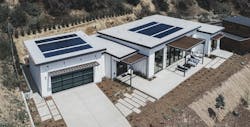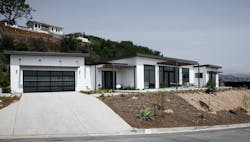How One Prefab Building Company Is Rebuilding Better in the Face of Disaster
The Thomas Fire in December 2017 burned nearly 282,000 acres in the California counties of Ventura and Santa Barbara. It reportedly destroyed 775 single-family homes and damaged another 200.
It was an ideal opportunity for Dvele, a three-year-old prefab home manufacturer, to showcase its first fire-resistant spec home under its California Wildfire Rebuild Initiative. Dubbed Skyview, the 2,280-square-foot single-level house, assembled on a burned-out lot, was built to wildfire mitigation standards set by San Diego county, which are considered tougher than the Wildland-Urban Interface Code that California follows, says Brandon Weiss, Dvele’s chief innovation officer.
The San Diego standard mandates such products as ember-resistant soffits (to keep fire detritus from getting inside the house), noncombustible siding, and dual-glazed R-20 windows. A rooftop solar array from Sunflare provides energy resilience. Skyview’s selling price was $1.4 million, including $550,000 in land costs.
Dvele’s rebuild initiative offers lower prices and faster build times than traditional rebuilding techniques, Weiss says, and can produce a house in its Loma Linda, Calif., factory and assemble it on site within four to six months, from permit to occupancy. The company’s website shows eight home plans ranging from 1,129 to 3,956 square feet and priced from $245,000 to $719,000, exclusive of land costs.
These all-electric models are built to Passive House and LEED specifications. They include roof-mounted 8.4-kW solar arrays and emergency power through built-in batteries. The homes’ biophilic design gives owners more exposure to the outdoors and the homes are also equipped with connected home features such as cellphone-controlled remote security and lighting and mesh Wi-Fi networks.
In the fourth quarter of 2019, Dvele will complete 11 homes. It expects to produce 60 to 80 homes in 2020, about half of which are likely to be rebuilds, Weiss says. For every house that Dvele makes, it offsets its carbon footprint by planting 10,000 trees.

